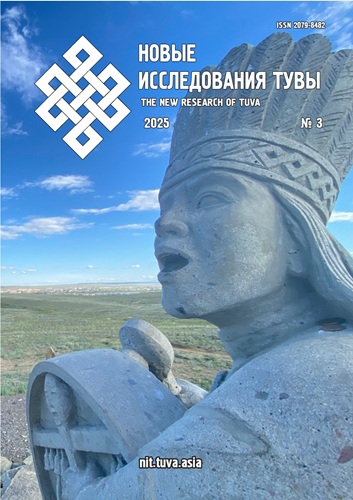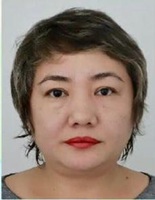Sources of comic effect creation in Kazakh and Tuvan literature
DOI:
https://doi.org/10.25178/nit.2025.3.5Keywords:
comic; laughter; satire; humor; Tuvan literature; Kazakh literatureAbstract
The article presents an analysis of various sources of comic effect in Kazakh and Tuvan literature. The research sources include works by contemporary Kazakh writers A. Artsishevsky and S. Muminov, as well as the Tuvan author V. Mongush.
It has been established that the comic in Kazakh and Tuvan literature conveys the worldview as well as the moral and ethical orientation of literary works, facilitating the construction of literary characters by characterizing their speech and behavior in specific situations. The comic is manifested in one of its forms — satire or humor — depending on the degree of deviation from socially acceptable norms of behavior and thought. Satire constitutes the author’s severe disapproval of a character’s behavior or mode of thinking. Humor, by contrast, is the author's good-natured ridicule of minor departures from social and moral norms.
An analysis of the works shows that the comic is organized differently in Kazakh and Tuvan prose. Comedy may serve as the primary source of comic effect. Plot-driven comic elements may be depicted by writers as the main source of comic effect. Authors employ various linguistic means as a primary source of comic effect. However, the presence of one principal source in a work does not preclude the use of other sources of the comic.
Comparative analysis demonstrates that the comic evolves from realism to postmodernism and is used to create a playful atmosphere.
References
Abazov, A. Ch. (2011) On the poetics of comic genres in Kabardian drama. Filologicheskie nauki. Voprosy teorii i praktiki, no. 2(9), pp. 12–14. (In Russ.)
Aristotel’ (1984) Poetics. In: Collected Works: In 4 vols. Moscow, Mysl’. Vol. 4. 830 p. (In Russ.)
Baktybaeva, A. T. (2023) Methods of conveying the comic in the modern Kazakh novel (on the example of the work by D. Satpayev and Ye. Zhumagulov “The Legend of NOMENCLATURE”). Mir russkogovoryashchikh stran, no. 3(17), pp. 115–127. (In Russ.)
Baktybaeva, A. T. and Bizhanova, A. A. (2023) Specifics of the comic in modern Kazakh prose (on the example of stories by Ye. Tursunov). Nauchnyi dialog, vol. 12, no. 5, pp. 250–268. (In Russ.) DOI: https://doi.org/10.24224/2227-1295-2023-12-5-250-268
Bakhtin, M. M. (1990) Rabelais and His World: Carnival Folk Culture of the Middle Ages and Renaissance. Moscow, Khudozhestvennaya literatura. 543 p. (In Russ.)
Borev, Yu. (1970) The Comic. Moscow, Iskusstvo. 270 p. (In Russ.)
Dzhundubaeva, A. A. (2015) Turning to myth in the contemporary Kazakh short story as a postmodern narration strategy. Vestnik KazNPU imeni Abaya. Seriya “Filologicheskie nauki”, no. 2(52), pp. 123–126. (In Russ.)
Dzemidok, B. (1974) On the Comic. Moscow, Progress. 224 p. (In Russ.)
Zabolotskaya, A. S. (2022) Features of translating comic devices in Russian fiction. In: Collected Scientific Papers Following the Research Work at the Institute of Foreign Languages of MSPU for the Academic Year 2021–2022 / ed. by E. A. Nikulina. Moscow, Moscow State Pedagogical University. 172 p. Pp. 60–63. (In Russ.)
Zaitseva, T. I. and Yamaeva, N. P. (2020) The comic in Udmurt folklore and fiction of the late 19th — early 20th centuries. Vestnik ugrovedeniya, vol. 10, no. 4, pp. 652–661. (In Russ.)
Karasev, L. V. (1989) Paradox of laughter. Voprosy filosofii, no. 5, pp. 47–65. (In Russ.)
Karasev, L. V. (1996) Philosophy of Laughter. Moscow, Russian Humanitarian University. 224 p. (In Russ.)
Kombu, S. S. (2012) Tuvan Literature: Dictionary / ed. by D. A. Mongush, M. L. Trifonova. Novosibirsk, Nauka. 359 p. (In Russ.)
Likhachev, D. S. and Panchenko, A. M. (1976) “The World of Laughter” in Ancient Rus’. Leningrad, Nauka, Leningrad Branch. 204 p. (In Russ.)
Nurmoldaev, D. M. and Zhaksilykov, A. Zh. (2022) The image of the mountain in Adolf Artsishevsky’s story “The Peak” in the aspect of the aestheticization of the ancient cult. Keruen, no. 4, vol. 77, pp. 109–119. (In Russ.) DOI: https://doi.org/10.53871/2078-8134.2022.4-09
Propp, V. Ya. (1976) Problems of the Comic and Laughter. Moscow, Iskusstvo. 183 p. (In Russ.)
Saveleva, V. V. (2014) The life we have molded for ourselves (On the stories of Salakhitdin Muminov). Prostor, no. 3, pp. 126–128. (In Russ.) DOI: https://doi.org/10.53871/2078-8134.2023.4-14
Saveleva, V. (2015) Stories in modern Kazakh prose: criticism and actualization of the genre. Neva, no. 2, pp. 188–211. (In Russ.)
Serikova, L. A. (2025) Intertwining identities: “One’s own — someone else’s — the other” in the stories of S. Muminov. Vestnik KazNPU im. Abaya. Seriya “Filologicheskie nauki”, no. 1(91), pp. 48–150. (In Russ.)
Stolovich, L. (1999) Philosophy. Aesthetics. Laughter. St. Petersburg; Tartu, s. n. 384 p. (In Russ.)
Tileubai, G. K. (2023) The role of online publications in the development of the contemporary Kazakh short story. Vestnik KazNU. Seriya zhurnalistiki, no. 3(69), pp. 110–119. (In Russ.)
Tileubai, G. K. and Tattimbetova, K. O. (2023) Genre trends in the development of the modern Kazakh realistic short story. Keruen, no. 4(81), pp. 174–186. (In Russ.) DOI: https://doi.org/10.53871/2078-8134.2023.4-14
Tileubai, G. K., Dzholdasbekova, B. U. and Tattimbetova, K. O. (2024) Semiotics of objects in the modern Kazakh short story. Vestnik Rossiiskogo universiteta druzhby narodov. Seriya: Teoriya yazyka. Semiotika. Semantika, vol. 15, no. 4, pp. 1389–1402. (In Russ.) DOI: https://doi.org/10.22363/2313-2299-2024-15-4-1389-1402
Kherel, A. Kh. (2015) The role of one-act plays by V. Sh. Kok-ool in the 1930s in the origin of the national Tuvan drama. Vestnik Buryatskogo gosudarstvennogo universiteta, no. 10, pp. 143–147. (In Russ.)
Published
How to Cite
For citation:
Unasbayeva G. A. and Shanaev R. U. Sources of comic effect creation in Kazakh and Tuvan literature. New Research of Tuva, 2025, no. 3, pp. 69-81. (In Russ.). DOI: https://doi.org/10.25178/nit.2025.3.5
Issue
Section

This work is licensed under a Creative Commons Attribution-NonCommercial 4.0 International License.

Author(s) license holder(s) grant rights for their work to the journal (grantee of a license) under the simple non-exclusive open license in accordance with Art. 1286.1 «Open license for a research work, work of literature or fine arts», Civil Code of the Russian Federation.
New Research of Tuva publishes articles under the Creative Commons Attribution-NonCommercial license (CC BY-NC).
Since it is an open license, author(s) reserve the right to upload the article to their institutional repository, submit it to another journal (if it allows republications), or republish it on their own website (in full, or in part).
However, several conditions apply here:
a) The republished version must always contain the name(s) and affiliation(s) of the author(s), the original title and the hyperlink to the original version on the New Research of Tuva website;
b) It must be in open access, free of charge, and no category of readers must be in any way whatsoever advantaged over general readership.
c) should the contribution be submitted elsewhere by its author(s) without substantial modification (30% or more of original text unchanged), the body of the article should contain a disclaimer that the original version was published in New Research of Tuva (with a link to the respective page)
The CC-BY-NC is a non-revocable license which applies worldwide and lasts for the duration of the work’s copyright.










